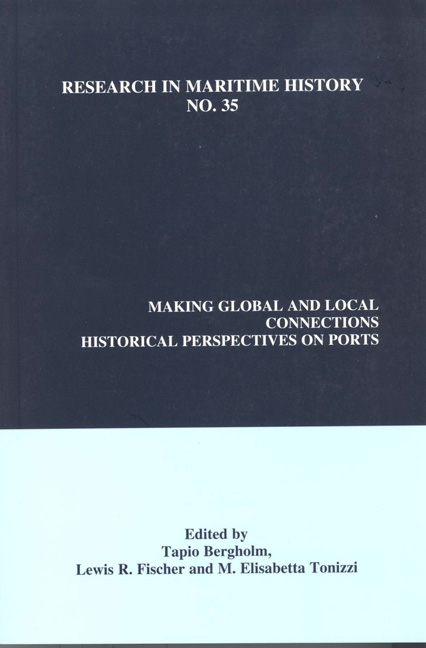Book contents
- Frontmatter
- Contents
- Contributors' Notes
- Contributors
- “Introduction”
- Part I Port Case Studies
- “The International Scope of Bordeaux Port: Logistics, Economic Effects and Business Cycles in the Nineteenth and Twentieth Centuries”
- “The Lancashire Cotton Lobby and the Making of the Manchester Ship Canal from 1883 to the Interwar Period”
- “Mormugao Port: The Golden Gateway to Goa”
- “New Perspectives on Port Competition: Antwerp and Rotterdam, 1945-1975”
- “The Environmental Impact of Ports: An Australian Case Study”
- “A Survey of the Operations of the Port of Kaohsiung, 1949-1957: The Policies for Survival?”
- Part II Port Systems
“A Survey of the Operations of the Port of Kaohsiung, 1949-1957: The Policies for Survival?”
from Part I - Port Case Studies
- Frontmatter
- Contents
- Contributors' Notes
- Contributors
- “Introduction”
- Part I Port Case Studies
- “The International Scope of Bordeaux Port: Logistics, Economic Effects and Business Cycles in the Nineteenth and Twentieth Centuries”
- “The Lancashire Cotton Lobby and the Making of the Manchester Ship Canal from 1883 to the Interwar Period”
- “Mormugao Port: The Golden Gateway to Goa”
- “New Perspectives on Port Competition: Antwerp and Rotterdam, 1945-1975”
- “The Environmental Impact of Ports: An Australian Case Study”
- “A Survey of the Operations of the Port of Kaohsiung, 1949-1957: The Policies for Survival?”
- Part II Port Systems
Summary
This brief paper investigates the performance of Kaohsiung, the biggest port in Taiwan, from 1949 to 1957, an era that should be thought of as the pre-takeoff period. The literature on port history in Taiwan is heavily concentrated on the years before 1945. Moreover, most research has been conducted from the perspective of economic geography. This paper will shed some new light on the subject, not only by looking at a later period but also by treating the Kaohsiung Port Authority (KPA) as a business corporation. I will use the archives from the Academia Historica in Taiwan to discuss the operation of the KPA from the assets revaluation in 1949 until 1957, when a Twelve-Year Development Plan for port development, a large Keynesian-inspired macroeconomic policy, was put into place. I will show that the authorities adopted a policy of “survival” during this period due to on-going, and largely economic, difficulties.
The port of Kaohsiung is located in the south-western part of Taiwan, a sub-tropical zone, 224 miles north of Keelung, 165 miles west of Amoy and 341 miles south of Hong Kong. Due to the nature of its sandy coast, dredging is always necessary to keep the port open. Kaohsiung was not developed under Chinese rule until it began to trade with Hong Kong in 1858. Taiwan was opened to foreign trade by the Tianjin Treaty between China and the United Kingdom. The British asked for trading rights at Kaohsiung in 1863, and a British consulate was opened in 1865. The British set out a plan to expand the port but never acted on it. Later, when the Chinese government began to build infrastructure it did so for defence against a possible French invasion rather than for commercial reasons.
Japan took over Taiwan after the Shimonoseki Treaty of 1895 and began to investigate Kaohsiung's potential in 1900. There were three development plans approved between 1906 and 1944. During this time Kaohsiung overtook Anping to become the biggest port in Taiwan despite the fact that the Japanese did not implement any of their plans fully.
During the Second World War, half the transport facilities in Taiwan were destroyed. Kaohsiung suffered heavy damage, and the Japanese even sank their own vessels to prevent an American invasion before they surrendered.
Information
- Type
- Chapter
- Information
- Making Global and Local ConnectionsHistorical Perspectives on Ports, pp. 107 - 112Publisher: Liverpool University PressPrint publication year: 2007
